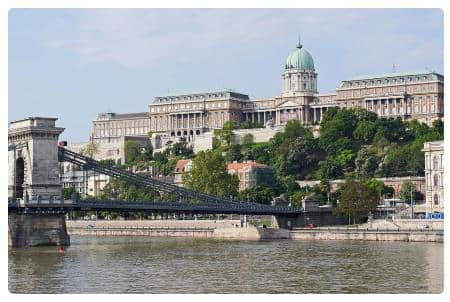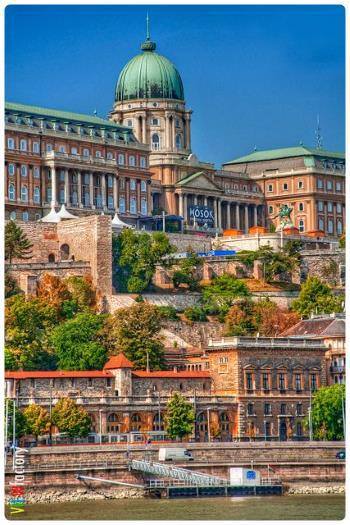|
You are here:
What to see in Budapest
>
Royal Palace of Budapest
|
Budapest's
Royal Palace, which today houses the President of the Republic of
Hungary, was the first royal residence on
Castle of Buda Hill (in Hungarian Budai Vár) built in
the 13th century after the Mongolian invasion. It was extended in the 14th
century, becoming probably the largest Gothic palace of the late Middle Ages.
The construction continued in the 15th century, after the marriage of King
Matthias Corvinus and Beatrice of Naples in 1476. Many Italian
artists and craftsmen accompanied the new queen, bringing Renaissance style
to Buda. The palace was completely destroyed when Buda was regained
to the Ottoman occupation army.
|
|
In the 18th century a small baroque palace was built, identical to the structure
of the current palace. During the Austro-Hungarian Empire, the building was home
to lush ceremonies that symbolized peace between the
Habsburg dynasty and the
nation after the 1848 uprisings. The reconstruction process of the Royal Palace
continued in the 19th century and was completed in 1904. Even at the end of the
Second World War, the palace was severely damaged, but it was rebuilt once again,
in neo-Baroque style, using many original parts.
Things to do and see at the Royal
Palace
 Today,
the Buda Castle complex houses some very interesting places to visit such as the
Hungarian National Gallery, the Budapest Museum of History and the
National Library. Other attractions include the Lion Courtyard, the
Matthias Well, a bronze statue of King Matthias Corvinus and the statue of the
Birds of Turul, the mythological bird of the Magyars If you can, visit the
complex at 12:00 to watch the spectacular Changing Guard. It is better to
be documented before you see all these concentrated attractions and take enough
time to visit them properly. At the end of the visit you can get off on foot
towards the
Chain Bridge. Today,
the Buda Castle complex houses some very interesting places to visit such as the
Hungarian National Gallery, the Budapest Museum of History and the
National Library. Other attractions include the Lion Courtyard, the
Matthias Well, a bronze statue of King Matthias Corvinus and the statue of the
Birds of Turul, the mythological bird of the Magyars If you can, visit the
complex at 12:00 to watch the spectacular Changing Guard. It is better to
be documented before you see all these concentrated attractions and take enough
time to visit them properly. At the end of the visit you can get off on foot
towards the
Chain Bridge.
The exhibitions of the National Gallery (buildings B, C, D) show the
history and development of Hungarian painting over the centuries. The collection
also represents the last five hundred years of Hungary's artistic history,
including the medieval and Renaissance stone, Gothic wood carvings and Gothic
altars. While many of the historical figures depicted on older works may be less
recognizable to visitors, late 19th century paintings will be more familiar.
Museum of Budapest History
The Budapest Museum of History (Edifice E) is dedicated to the history of
Budapest. Although there are not many artifacts surviving the medieval palace of
yesteryear, a short visit is certainly recommended.
Of course, the gardens of the Royal Palace are also worth seeing, from where you
can enjoy a complete overview of the Pest area on the other side of the Danube
and the main monuments of the city.
To get to the Royal Palace you can take the picturesque funicular from
the Chain Bridge, or the public bus that serves the Castle Hill called Várbusz
from Széll Kálmán tér (formerly Moszkva tér) or one of the many paths that lead
to the top of the hill itself. Take bus no. 16 from Deák Ferenc tér to Dísz tér
(in the centre of Pest) or the Sikló funicular, which opened in 1870, and
arrives near the Royal Palace. Alternatively, you can walk to the so-called'
royal staircase' of Király lépcs? from Clark í dám tér Square, or take the
minubus to Várbusz or Dísz tér.
Buda Castle complex (Budavári Palota or Budai Vár)
Area: Szent Gyorgy Ter / Buda (historical centre)
Budapest
Copyright © Informagiovani-italia. com. Reproduction in whole
or in part, in any form, on any medium and by any means is prohibited
without written permission.
If you liked this guide and would like to help Informagiovani-italia. com
help us spread it.
Where is
it located?
Back up
Ostelli
Ungheria
Hotel in Ungheria
Carte de Budapest Karte von Budapest Mapa Budapest Map of Budapest
Carte de Hongrie Karte von Urgan
Mapa Hungría Map of Hungary
|
